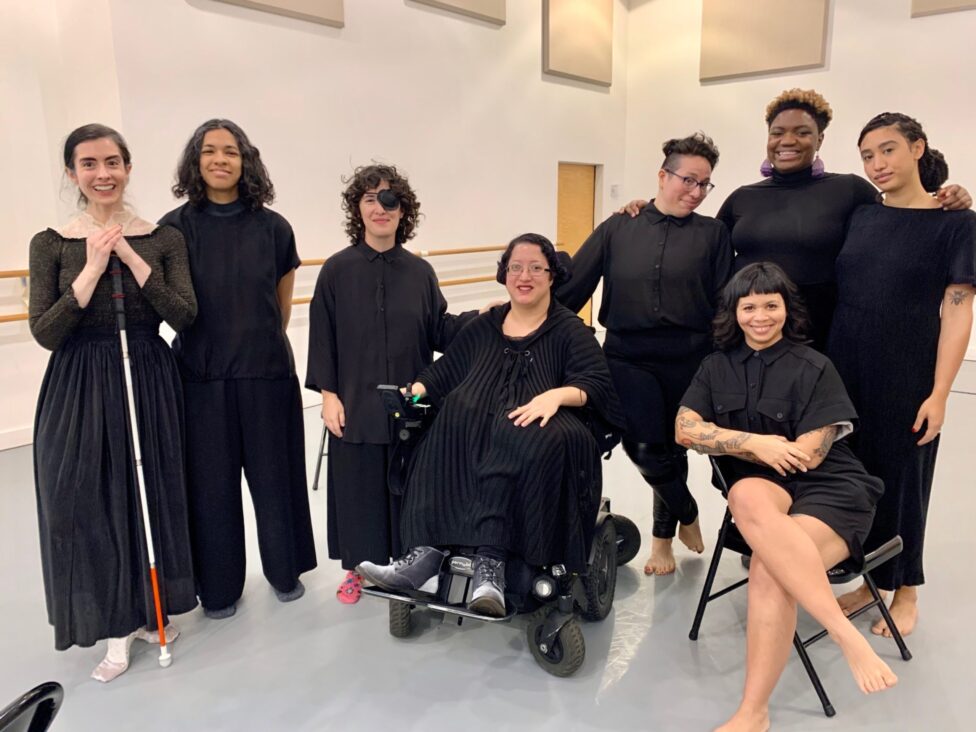A Conversation with iele paloumpis and Marielys Burgos Meléndez
iele paloumpis: It’s amazing to have a little bit of distance from performance at this moment. I was so enmeshed and immersed in this epically long process and project for so many years. It’s nice to have this moment of being able to reflect upon it and feel moments of nostalgia.
I’m reminded of the first day we grew as a cast – when we basically doubled in size to what became the full core cast. When we invited our audio describers into the process.
We knew we were going to work with audio description, because we want to center blind and visually impaired audiences. We were also recognizing that who described us really mattered. Each of us have these different embodied histories and it was really important that we felt trust in the people that were going to be describing us.
So then we were essentially doubling our core cast in size. And it was a real collaborative effort to find the right fits.
Marielys Burgos Meléndez: I think this is some labor of love you did.
ip: That’s true. Thank you for that.
When we started in a smaller group with just you, Marýa, and Krishna, it was at this intersection of what spiritual connections and affinities we have with one another. Then how we expanded felt really important.
For you and Marýa, I remember, there was a search process. There were things that you had in mind that would make it so you would be able to connect with a person. Krishna knew right away, she was “I want Alejandra.” She knew exactly who it was going to be.
I think that the audio describers had a feeling of coming into a process that had been going on for longer than they had been there. They were coming into something that was already established.
MBM: I think of the creative process as a relational dynamic. Who do we want to establish relationships with and how do we want to grow together in those relationships? I am coming back to the thought of the creative process as a potential dynamic of exploring relationships.
I’ve always been a person that has felt affinity within creative process and I’ve worked closely with friends as a freelancer. Some of my roommates have ended up being my co-workers or my co-workers have ended up being my roommates and then I have grown really long-term relationships with people in different roles.
I don’t want to call those relationships that happen or emerge as part of a creative processs experiments because I don’t think we experiment with people or relationships per se. In our rehearsals I think we’re experimenting with art and art making and access tools and in that researching we got to know each other on a deeper level because we wanted to and because there were some conditions that we set up for that to happen. That doesn’t happen all the time.
ip: Definitely.
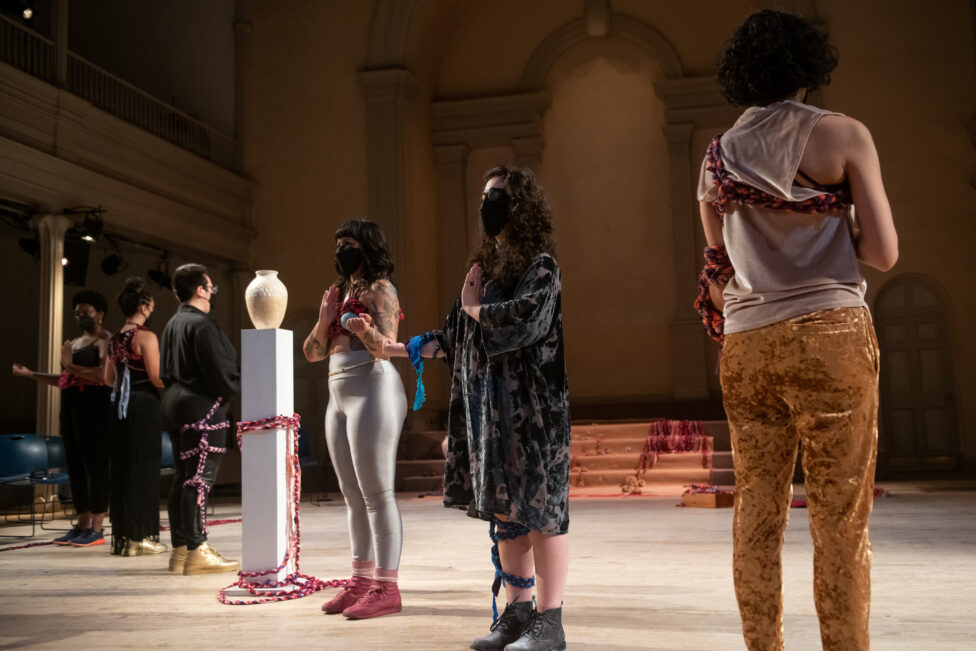
[ID: In place of catastrophe, a clear night sky. Six performers stand in a diagonal line, facing different directions as they enact sacred hand gestures. In the center is an Armenian-style vase made from mycelium placed atop a tall white pedestal. The performers and pedestal are adorned with woven harnesses. The costumes range from matte black to metallic or colorful velvet. All wear K95 masks and different bright sneakers. From left to right: Ogemdi Ude, Seta Morton, M. Rodriguez, Marielys Burgos Meléndez, iele paloumpis and Marýa Wethers.]
Photo by Ian Douglas/courtesy Danspace Project.
MBM: Crisis can bond or pull people apart depending on where people are in those processes.
We were in a space of deep care with one another even though the pandemic was affecting us, each in different ways. Some of our core members are disabled people, some of us immunocompromised people, some others were working directly related to the medical field.
ip: Yes.
MBM: It became a social responsibility to me to continue to be part of our process. Our meetings were a place that held me as I was. Not necessarily having to “leave the shit at the door,” as you said, but to actually work through whatever sensations, whether they were joyful or not so joyful.
For me, it became an invitation to be present, because I could be in the wholeness of my experience without fragmenting myself. The codes and consent-based agreements that we created in our creative process prior to the pandemic really resourced me to be able understand what I needed, how I needed it. How to ask for it and how to give to myself emotionally and physically.
ip: We’re going through this major crisis. Everyone in the world has been changed by this pandemic. Fundamentally.
It’s helpful for me to think historically about this. I’m part of a group, What Would an HIV Doula Do? We do a lot of work around HIV and AIDS activism and there’s some people who are and have been there for the early parts of the AIDS crisis with ACT UP. It’s helpful to look at the wisdom of these organizers. There’s a term that was used during the AIDS crisis… the big ACT UP slogan was “silence equals death.”
Looking back at it, there’s these periods of silence, these waves of silence. And then there were these moments of pushing back against that silence and pushing back against the government’s inaction. I’m thinking of it like the long arm of history, which helps anchor me. It helps me realize, okay, there are things to draw upon here.
The pandemic could be a portal, you know? For change. And a lot of transformation. It’s interesting to reflect on intergenerational trauma. How wounds get passed down. How to tend to those wounds.
How we tend to those wounds is by caring for one another. By coming to a place of truth-telling and honesty and holding what’s in the room with each other with a lot of care and patience and negotiation and consent.
How we were working together. I remember asking: How do we establish trust between each other?
It’s really fascinating to watch this traumatic event that we, as a world, keep going through, and then see how trauma replicates itself.
This desire to dissociate and be in denial to get back to this idea of “normalcy.” It actually can be quite harmful, and essentially is perpetuating the harm. It has demonstrated to me, in real time, how trauma continues to get passed down.
MBM: Yes!
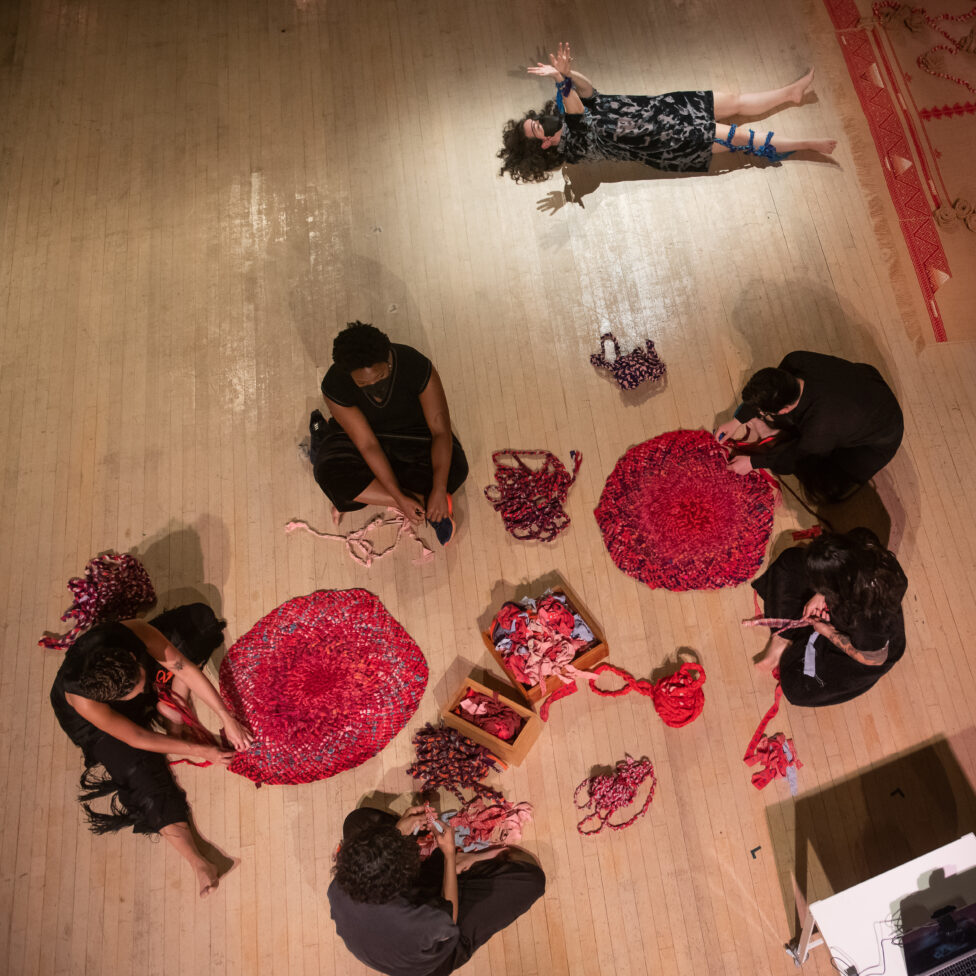
[ID: Five in-person cast members sit in a circle, engaged in a weaving practice while iele lays on their back with arms reaching upward, slightly offset from the group. Clockwise: M. Rodriguez, Marielys Burgos Meléndez, Marýa Wethers, Seta Morton, and Ogemdi Ude. A small white desk with a laptop sits in the corner as the embodiment of one of the virtual cast members. The camera shot is taken from an aerial view, looking down at the performers as they create circular rugs and long braids. The red textiles contrast with the dark clothing of the performers who sit on the blonde wood floor of St. Mark’s Church.]
Photo by Ian Douglas/courtesy Danspace Project.
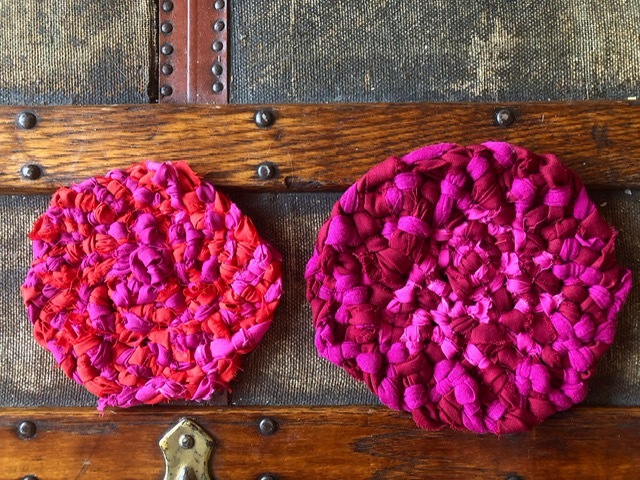
[ID: Two bi-colored woven circles are arranged next to each other on top of a storage trunk. The circle on the left is smaller, light pink, and coral. The circle on the right is light pink and fuchsia.]
Weavings by iele paloumpis
Photo by Marielys Burgos-Meléndez
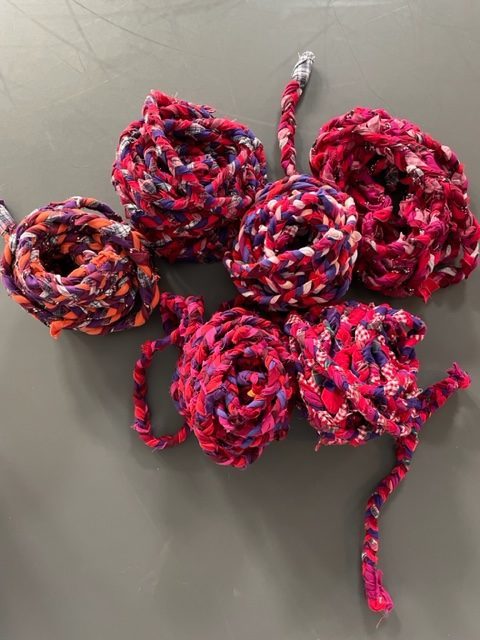
[ID: Six coils of braided fabric are coiled and arranged closely together on gray marley flooring. The fabric is pink, purple, orange, and white.]
Weavings by iele paloumpis
Photo by Marielys Burgos-Meléndez
ip: I think what you’re saying about the importance of our group establishing these consent-based relational practices before the pandemic hit—it let us establish a baseline of trust and open communication and negotiation with one another. I’m so grateful that that’s what we were able to build.
MBM: Building!
ip: That we are co-building and co-creating together. It wasn’t easy. I don’t want to paint it as a utopia because it wasn’t.
MBM: There was also tension when needs were—I don’t want to call it against each other—but in conflict with one another. Whether that is safety or time or engagement. I don’t think we have enough good references of how messiness actually manifests and how that messiness can be held with so much love and acceptance.
I remember this moment of agreeing: so what is the baseline? The baseline is whoever has the most vital need. For example, if a PCR test was the baseline for one person to feel safe, then we would all do a PCR test. I see these actions as embodiments of love.
ip: Right. Once we came to our agreements, we established a level of trust and understanding about how we all felt comfortable coming together and reached this area of consent.
And even with that, we remained a hybrid cast, so we had virtual performers all the way through the end of the performance. Which established that, if at any point, anyone needed to go virtual, that was always available to you. For whatever reason. I think this helped create a real safety net and fluidity of choice-making.
MBM: Totally, I feel this.
ip: In a lot of ways, navigating in this moment of crisis and learning to move through it with adaptability and consent, is really hard. It’s really hard.
Especially as the director, and the person that was sort of feeling responsible for everybody. That was a huge weight I felt personally on my shoulders.
MBM: I want to remind you, iele, that there were moments in which, we as a group, reminded you: Hey, you also have needs?
ip: Yes, no, totally. I think it’s really profound that there were a handful of times that I just couldn’t be there at all. And that was okay.
MBM: This reassures me. It reassures me of the kinds of relationships that I want to establish, whether that is in a creative process or in my everyday life—making no distinction—because my creative process is everyday life.
What are the rhythms that are needed for us to carry on the work? What are the rhythms of the work? What is a timeline that will really prioritize humanity inside a project? That is a huge question for me. What workload can I hold onto? How can I make space for my needs?
I feel these questions. I could hold them inside of the project we did together.
ip: I think that there was something in that initial seed of our research together, back in 2018, where we decided we were going to look at epigenetics and resilience and ask: What are the tools for transmuting pain and alchemizing it into care?
I know that I was drawn to those themes, in part, because of my own estrangement from my blood family—the majority of my blood family—which is a huge wound for me.
And I’ve realized that trauma doesn’t happen in a vacuum or in isolation. It’s relational. Trauma and care get enacted in community.
There was something about that first seed, this idea of relationality and healing through relationality, that set us up to be able to offer that care through the crisis that we have lived through and are living through together.
In some ways, I feel there’s divine timing. I can feel our ancestors at our backs helping us make it through the past few years.
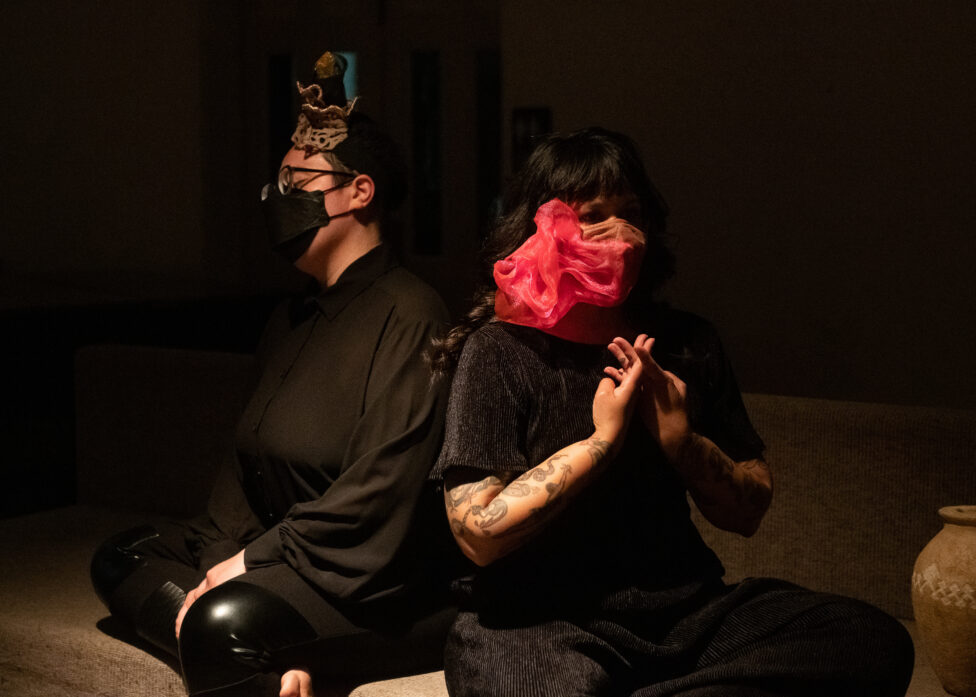
[ID: M. Rodriguez (left) and Marielys Burgos Meléndez (right) sit cross-legged and perpendicular to one another in a darkly lit place with carpeted floor. They are illuminated by warm light. M., a large bodied white Latinx queer human, wears a black button-up shirt, glossy black pants, a black kn95 mask, large rounded glasses, and a small tan headpiece. Marielys, an afroarawak descent female, sits facing an Armenian-style vase made from mycelium placed on the floor in front of her. She is wearing a black, ribbed, shiny jumpsuit and a tan mask with ruched pink chiffon attached to it. Her dark hair is braided and she is holding her hands with interlocked fingers at her chest.]
Ian Douglas, courtesy of Danspace Project
MBM: Yes, they’ve been with us. And we’ve been with us. I’d like to finish by sharing how I am taking care of myself now.
I have been using joy as an antidote to deep trauma. Joy as an embodied practice that can connect the fragmentation of my body-brain or my body-mind-spirit. I’ve been pole dancing! Saturdays are now sacred times for pole dancing. I feel the divine in the collective commitment to be truthful to our desires and ‘sensuousness’ through pole dancing.
I’m giving myself gentle loving pushes to give more effort, even though this can be hard with my history of multiple surgeries. I’ve been re-writing my nervous system through fitness. I used to feel blocked or scared to move through, for example, workout palpitations. Now I am learning to understand how to feel safe while working out even though I might feel a heart palpitation or nervous system ‘activation’. It has been a re-learning process.
How are you taking care of yourself, iele?
ip: How do I care for myself? I’m needing to rest more than I ever have known. It does seem that I have long COVID, which is exacerbating some of my underlying conditions. I’m not able to move my body in the same ways that I could pre-pandemic.
I have this heart arrhythmia now, so I’m also having to slow down and re-learn and re-get to know my body.
That’s a process of patience and flexibility and adapting and deep listening. It can be frustrating. It can be—it is liberating.
I’m also learning to drum. I’ve been learning to play the bendir, which is a drum from the Anatolia region of my ancestors. Feeling that rhythm of the drum reverberate through my body feels very grounding and very soothing to my nervous system. And connecting to that heartbeat has been a balm as my body produces an irregular heartbeat on its own. That feels powerful in this moment. Yeah.
MBM: Before we take off, I want to also bring to the space the presence of Seta Morton, Ogemdi Ude, M. Rodriguez and Alejandra Ospina. They’ve been present throughout the conversation, and I just want to name them.
ip: Name them! I thought that too. We need to name them.
MBM: As presences, as spirits, and as beings that were all part of this process.

